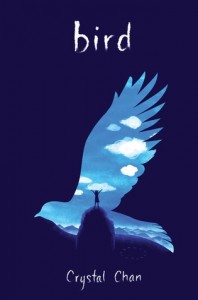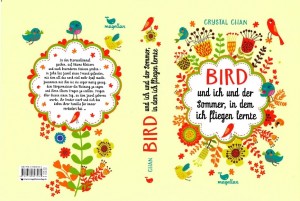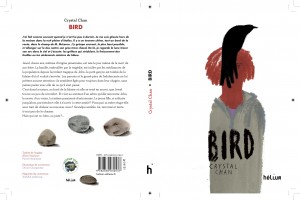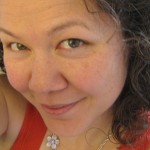 “Grandpa stopped speaking the day he killed my brother, John. His name was John until Grandpa said he looked more like a Bird with the way he kept jumping off things, and the name stuck. Bird’s thick, black hair poked out in every direction, just like the head feathers of the blackbirds, Grandpa said, and he bet that one day Bird would fly like one too. Grandpa kept talking like that, and no one paid him much notice until Bird jumped off a cliff, the cliff at the edge of the tallgrass prairie, the cliff that dropped a good couple hundred feet to a dried-up riverbed below. Bird’s little blue bath towel was found not far from his body, snagged on a bush, the towel that served as wings. From that day on, Grandpa never spoke another word. Not one.”
“Grandpa stopped speaking the day he killed my brother, John. His name was John until Grandpa said he looked more like a Bird with the way he kept jumping off things, and the name stuck. Bird’s thick, black hair poked out in every direction, just like the head feathers of the blackbirds, Grandpa said, and he bet that one day Bird would fly like one too. Grandpa kept talking like that, and no one paid him much notice until Bird jumped off a cliff, the cliff at the edge of the tallgrass prairie, the cliff that dropped a good couple hundred feet to a dried-up riverbed below. Bird’s little blue bath towel was found not far from his body, snagged on a bush, the towel that served as wings. From that day on, Grandpa never spoke another word. Not one.”
So begins Crystal Chan‘s debut middle grade novel Bird (Atheneum Books for Young Readers, 2014), planting the seeds that will grow into a story that explores weighty topics like the fallibility of parents and friends, the pain of silences, and the way death can cause fractures in a family only love and time can heal, all in age-appropriate and tender ways. Through the eyes of Bird‘s mixed-race main character Jewel, Chan examines the at times confusing intersection of religion, superstition and culture — sometimes even within a family — that often colors a child’s experience of the world. Twelve-year-old Jewel’s humor, heart, and love of science, as well as her exploration of the everyday and sacred in her midwestern home, all lend important texture and context to the story.
“Nothing matters. Only Bird matters. And he flew away.
Jewel never knew her brother, Bird, but all her life she has lived in his shadow.
She lives in a house drenched in silence. Filled with secrets.
Then one night, a boy in a tree changes everything…”
I’m thrilled to talk with Crystal about her debut novel, Bird:
E. M. Kokie: Your main character, Jewel, is a mixed-race kid growing up in the midwest. How much of your own experiences infused or inspired Jewel’s experiences?
Crystal Chan: I drew on a ton of my experiences growing up as a mixed-race kid! I’m half-Chinese, half-white, and in my small-town Wisconsin in the 80’s there was no mixed race anything – we really stuck out. I got a lot of the racism from being of Chinese descent, which my dad (from Hong Kong) could relate to, but then I also had the mixed-race experience (and perpetual “what are you?” question) that he couldn’t relate to, not in that way. So while Jewel is of a different mix than myself – she’s Jamaican/Mexican/White – and though I had to do a lot of research on Jamaican and Mexican cultures, I felt very much at home writing about how she straddled multiple worlds and multiple sets of expectations at home and in her hometown.
EK: I found the intersection of religion, spirituality and superstition in Bird really interesting, especially the idea of how people of faith view the faiths of others. What inspired you to tackle such weighty themes in Bird?
CC: Well, you know how they say to write the book you wanted to read as a child? (laughing) I’ve always been interested in the realms of faith and conflicting belief systems. My father was very superstitious, but we could never talk about death, for example.
In Bird, there are conflicting belief systems in Jewel’s family that come from her mixed heritage. Actually, I think that conflicts in belief systems happen a lot in families – maybe not to the same degree, but they’re there – and that leaves kids confused as to how they should understand their world. Hopefully, this book helps kids form their own questions, questions that they’re probably already having. I was an advanced reader growing up, and I completely believe in the capacity of kids’ understanding and questioning and their desire to stretch themselves, to take a step toward being a grown-up. And that means tackling weightier issues, like belief and doubt. Never underestimate the depth of children, I say! And so I wrote a story that believed in children’s depth.
EK: Jewel has adopted the cliff where her brother Bird died as her own sacred place. Do you have sacred places, now or as a child?
CC: I totally had a sacred space, and to get there I had to trek through some farmers’ fields; it was a little forest grove with a stream running through it. That space was my sanctuary through some rough years, and having a sacred space like that – where I could just be me – fully informed the sacred spaces in Bird. No doubt about that.
EK: John’s feelings about being adopted is a perspective I haven’t seen represented very often in literature for children and teens. I wondered what inspired his perspective?
CC: I read a scholarly essay once entitled “Raised by White People” – talking about the experience of the transracial adoptee, and as I was reading it I was struck at how many similarities there are between transracial adoptees and those who are mixed race. For instance, the children both don’t look like their parents and don’t have their parents’ racial experiences. And so forth. In writing Bird, I knew that a transracial adoptee would be the perfect friend for Jewel (the protagonist), both of them sticking out, not fitting neatly into any defined box. Of course, there are differences between a transracial adoptee and mixed race kid, and Jewel and John explore some of those differences, but I thought the two kids’ experiences would complement each other really well.
EK: I read that Bird has already been published in a number of countries outside the United States. How many languages has it been translated into? Were you surprised that such a culturally specific story, rooted firmly in the midwest United States, has found such a large international audience?
CC: As of now, Bird is in nine countries and out on audiobook domestically. Yeah, I was shocked when we landed Australia, the first country. I was like, But the book is so strongly set in Iowa – in cornfields! The Midwest! How does this even translate to another country? But then other countries started rolling in, across different continents, too. I was confused for some time…but after a while, their excitement started to make sense. Some of the countries that were the strongest supporters – like Australia, the UK, Brazil, Turkey – have very diverse and mixing populations, and kids who have to deal with larger identity questions as a result. Other countries surprised me – like Korea, which has a reputation of being more mono-cultural – but the truth is that racial mixing is happening everywhere, and these questions about race and identity aren’t going to go away. In fact, these questions will only deepen, no matter the stage where the society is at. And I’m honored and proud that Bird is a book that can deepen that conversation.
EK: The cover for the U.S. edition of Bird is beautiful, and so representative of Jewel’s relationship with her world. Are there any of the foreign covers that you especially love? Any that you were surprised by?
CC: I haven’t seen all the covers just yet, as different countries have different timelines for publication, but I have to say, I was surprised by the starkness of the French cover, and then the cheeriness of the German cover. It’s like, is this even the same story? And as beautiful as the Dutch cover is, the girl featured on the cover does not represent the Jewel I wrote (Jewel has frizzy, black hair, while the girl on the cover has straight, flowing hair). All of the other countries thus far have chosen the U.S. cover. In that respect, just as the story is touching a universal nerve, the cover image is, too. It still strikes me as remarkable: as precise as this story is, with the setting and culture, it’s tapped into a common language, a common sentiment. I cannot think of a greater honor.
Thank you, Crystal! It’s wonderful to see Bird, flying far and wide, and finding its way into the hands of young readers around the world and here at home.
Crystal Chan grew up as a mixed-race kid in the middle of the Wisconsin cornfields and has been trying to find her place in the world ever since. Over time, she found that her heart lies in public speaking, performing, and ultimately, writing. She has given talks and workshops across the country; facilitated discussion groups at national conferences; is a professional storyteller for children and adults alike; and contributes to Wisconsin Public Radio. In Chicago, where Crystal now lives, you will find her biking along the city streets and talking to her pet turtle.


